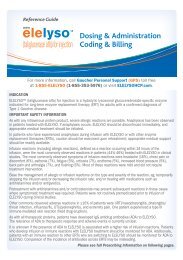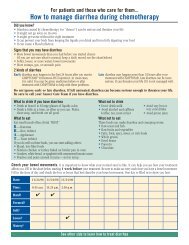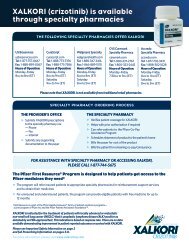SOMAVERT - PfizerPro
SOMAVERT - PfizerPro
SOMAVERT - PfizerPro
- No tags were found...
You also want an ePaper? Increase the reach of your titles
YUMPU automatically turns print PDFs into web optimized ePapers that Google loves.
AcromegalyPatient ViewIncidence and prevalence 1, 7• The incidence of acromegaly is approximately 3-4 casesper million persons per year• < 20,000 cases in the United States• The prevalence is about 60 cases per million• Men and women are diagnosed equally with acromegaly• Mean age at diagnosis = 40 years1, 8, 9Types of pituitary tumors• Pituitary tumors account for about 15%of intracranial neoplasms• Four main pituitary tumors are related to:PituitaryglandLactotroph(prolactinoma): 40-50%Corticotroph(Cushing’s): 10-15%Thyrotroph(hyperthyroid): 1-5%<strong>SOMAVERT</strong> is indicated for the treatmentof acromegaly in patients who have had aninadequate response to surgery and/or radiationtherapy and/or other medical therapies, or forwhom these therapies are not appropriate.The goal of treatment is to normalize serumIGF-I levels.The most common adverse events (>10% andat frequencies greater than placebo) in 1 of the3 active treatment arms in a placebo-controlledstudy (N=112) included infection, pain, diarrhea,nausea, flu syndrome, abnormal liver functiontests, and injection-site reaction.Somatroph(acromegaly): 30%Most pituitary tumorsare not malignant 1
Relationship Between GH and IGF-IBrainPituitary gland makes GHWhat causes the signs andsymptoms of acromegaly? 3• When there is too much growth hormone(GH) in your body, it triggers the bodyto make too much insulin-like growthfactor I (IGF-I)• This causes organs and tissuesto grow too much• Other signs and symptoms ofacromegaly may also appearGH triggers your bodyto make IGF-IGH & IGF-I cause tissuesand organs to growImportant Safety InformationSome people who have used <strong>SOMAVERT</strong>have developed liver problems. Theseproblems generally disappeared whenthose people stopped taking <strong>SOMAVERT</strong>.RelationshipBetween GHand IGF-I
Managing Signs and SymptomsPatient ViewIn the fixed-dose pivotal trial<strong>SOMAVERT</strong> ® (pegvisomant for injection) providedimprovements in signs and symptoms at each dose 4Improvement in total score for signs and symptoms for all dose levelsof <strong>SOMAVERT</strong> vs placebo at week 12 62<strong>SOMAVERT</strong>+1.310 mg/day 15 mg/day 20 mg/dayAdapted from Trainer et al. 4(n=26) (n=24) (n=26)0Placebo(n=30)-2-2.5-4-4.4 -4.7-6Total score for signs and symptoms*For a difference in mean change from baseline versus placebo (Dunett’s test).• Total score for signs and symptoms was defined as the sum of all scoresfrom 0=absent to 8=worst for symptoms including fatigue, perspiration,headache, arthralgia, and soft tissue swelling 6• At 12 weeks, mean % change from baseline increased (worsened) 16%for placebo, and decreased (improved) 8% for 10 mg, 20% for 15 mg,and 33% for 20 mg 11• At 12 weeks, ring size was smaller (improved) in groups treated with15 or 20 mg of Somavert, compared with placebo 6Mean change from baseline(total score)Randomized, double-blind, multicenter, placebo-controlled, fixed-dose,12-week study in 112 patients with acromegaly previously treated withsurgery, radiation therapy, and/or medical therapy. Mean baseline totalscore for signs and symptoms was 15.2In a post-hoc analysis of the same study,91% of patients who achievednormalized IGF-I levels alsoexperienced improvements in theirtotal signs and symptoms scoreof acromegaly 11Study description: For the post-hoc analysis, a subset of 57 patients wasidentified as having both IGF-I normalization and reported any signsand symptoms of acromegaly at or after the visit at which IGF-I levelswere normalized 4Important Safety InformationPatients on opioids often needed higherserum pegvisomant concentrations to achieveappropriate IGF-I suppression compared withpatients not receiving opioids.P=.022 * P=.001 * P
IGF-IIn a long-term dose-titration trial,92% of patients (35/38) treated with <strong>SOMAVERT</strong> ®(pegvisomant for injection) achieved IGF-I reductionswithin age-adjusted normal range after a mean of 55 weeks 6Patient View2500200094% 83% 100%15001000normalrangewithin normalrangewithin normalrange500025-39 (n=17) 40-54 (n=12)Age (years)≥55 (n=9)Baseline Nadir IGF-I level with <strong>SOMAVERT</strong> Normal IGF-I range (age-adjusted)In these patients, IGF-I levels remained normalized atSerum IGF-I (mg/mL)Adapted from van der Lely et al. 10Data from a long-term, dose-titration trial in 160 patients treated with<strong>SOMAVERT</strong> for an average of 425 days. Dosing began at 10 mg/dayand was titrated up or down as necessary in 5 mg/day increments untilthe patient’s serum IGF-I levels were normal or until the maximum dose(in this study) of 40 mg/day was reached (mean dose at 12 monthswas 18.0 mg/day; mean dose at 18 months was 19.6 mg/day). Datapresented are from a cohort of 38 patients in a long-term, open-label,dose-titration extension trial in which patients with acromegaly weretreated for at least 18 consecutive monthsImportant Safety InformationTumors that secrete GH may expand and cause serious complications. All patients with GH-secreting tumors, including thosereceiving <strong>SOMAVERT</strong>, should be carefully monitored for changes in tumor volume.The maximum indicated daily maintenance dose for <strong>SOMAVERT</strong> is 30 mg.Injection sites should be rotated daily to help prevent lipohypertrophy.IGF-I
IGF-IWhat is IGF-I? 1, 3• IGF-I stands for insulin-like growth factor-I• In acromegaly, your body makes too much IGF-Iand parts of your body grow too muchWhy is it important to control myIGF-I levels if I have acromegaly? 11• Keeping IGF-I levels within the normal rangefor people your age generally:• Suggests that your disease is under control• Helps to improve the signs and symptomsof acromegalyWhat treatments may helpme manage the symptomsof acromegaly? 5• For most patients, the first treatment is surgeryto remove the tumor or reduce its size• Many patients also need prescription medicines to helpcontrol their hormone levels, including IGF-I levelsUntreated symptomsTreated symptomsSweating morethan normalJointpainSoft tissueswellingIGF-I
How <strong>SOMAVERT</strong>® (pegvisomant for injection) WorksPatient View<strong>SOMAVERT</strong> is a growth hormone receptor antagonist (GHRa) 6<strong>SOMAVERT</strong> effectively binds to GH receptors on cell surfaces• Blocks the binding of endogenous GH• Reduces IGF-I production• The initial increase in GH levels is attributed to loss of negative feedbackinhibition and does not diminish the efficacy of <strong>SOMAVERT</strong>Growth HormoneGrowth Hormone Receptor antagonist(<strong>SOMAVERT</strong>)IGF-IGHGHGH receptorBodyGHRaGH receptorBodyImportant Safety InformationFunctional effects of increasedGH are prevented by GH receptorblockade; therefore, patients on<strong>SOMAVERT</strong> should be carefullyobserved for the clinical signs andsymptoms of a GH-deficient state.In subjects with systemichypersensitivity reactions, cautionand close monitoring shouldbe exercised when re-initiating<strong>SOMAVERT</strong> therapy.How<strong>SOMAVERT</strong>Works
<strong>SOMAVERT</strong>® (pegvisomant for injection)Patient ViewIn a fixed-dose pivotal trial,<strong>SOMAVERT</strong> demonstrated a dose-dependentimprovement in IGF-I normalization 6Percentage of patients achieving a normal serum IGF-I at week 12 6Patients (%)10050039%75%82%10% P=.02 P
<strong>SOMAVERT</strong>® (pegvisomant for injection)What can I expect from treatmentwith <strong>SOMAVERT</strong>? 6The goal of treatment with <strong>SOMAVERT</strong> is to reacha normal IGF-I level in the bloodIn 2 clinical trials, the majority of patients treated with<strong>SOMAVERT</strong> achieved normal IGF-I levels for their age• 92% of patients treated with <strong>SOMAVERT</strong> achieved normalIGF-I levels in a long–term study (at 55 weeks)• This data comes from a part of a study involving 38 of theoriginal 160 patients who received <strong>SOMAVERT</strong>. Their dose of<strong>SOMAVERT</strong> was changed until their IGF-I levels were normalVials notactual size• 82% of patients treated with 20 mg/day of <strong>SOMAVERT</strong> achievednormal IGF-I levels in a short–term study*• In the same short-term study, the overall signs and symptomsof acromegaly improved in patients who took <strong>SOMAVERT</strong>compared with those who didn’t take any medicine— This study showed how patients rated the change in theirsymptoms, which included joint pain, headaches, fatigue,sweating, and soft tissue swelling*This data is from a 12-week clinical trial that involved 112 patients withacromegaly: 31 patients received no medicine; 80 were treated with <strong>SOMAVERT</strong> atone of three doses. Results for patients achieving normal IGF-I levels for their agewere as follows: 10% of patients taking no medicine; 39% of those on 10 mg/dayof <strong>SOMAVERT</strong>; 75% of those on 15 mg/day; 82% of those on 20 mg/day.Important Safety InformationBlood sugar levels may go down when taking <strong>SOMAVERT</strong>.Be sure to tell your doctor if you use insulin or other medicines(oral hypoglycemic medicines) for diabetes. The dose of thesemedicines may need to be reduced when you use <strong>SOMAVERT</strong>.Actual size for self-administered, at-home injectionIf you need help affording yourtreatments, Pfizer can help eligiblepatients through the <strong>SOMAVERT</strong>Copay/Coinsurance Support Programand the Pfizer Bridge ProgramThe most common side effects with <strong>SOMAVERT</strong> are pain, infection,reaction at the injection site, flu-like symptoms, nausea, and diarrhea.These are not all of the possible side effects of <strong>SOMAVERT</strong>. For moreinformation, speak to your doctor.<strong>SOMAVERT</strong>
<strong>SOMAVERT</strong>® (pegvisomant for injection) Safety InformationIndication<strong>SOMAVERT</strong> is a prescription medicine for acromegaly.It is for patients whose disease has not been controlledby surgery, radiation, and/or other medical therapies,or patients for whom these options are not appropriate.The goal of treatment with <strong>SOMAVERT</strong> is to have a normalIGF-I level in the blood.Important Safety Information for PatientsDo not use <strong>SOMAVERT</strong> if you are allergic to <strong>SOMAVERT</strong>or anything that is in it.Be sure to tell your doctor if you use narcotic painkillers(opioid medicines) because the dose of <strong>SOMAVERT</strong> mayneed to be changed.Tumors that make growth hormone may grow in peoplewith acromegaly. Studies have shown that the size of thesetumors generally does not change for people who use<strong>SOMAVERT</strong>. Even so, these tumors need to be watchedcarefully by your doctor. Your doctor may ask you to havea magnetic resonance imaging (MRI) test to monitor the sizeof your tumor.Blood sugar levels may go down when taking <strong>SOMAVERT</strong>.Be sure to tell your doctor if you use insulin or othermedicines (oral hypoglycemic medicines) for diabetes.The dose of these medicines may need to be reducedwhen you use <strong>SOMAVERT</strong>.Some people who have used <strong>SOMAVERT</strong> have developedliver problems. These problems generally disappearedwhen those people stopped taking <strong>SOMAVERT</strong>.Stop the drug right away and call your doctor if you getany of these symptoms:• Your skin or the white part of your eyes turns yellow(jaundice)• Your urine turns dark• Your bowel movements (stools) turn light in color• You do not feel like eating for several days• You feel sick to your stomach (nausea)• You have unexplained tiredness• You have pain in the stomach area (abdomen)Your doctor may do blood tests before and during yourtreatment with <strong>SOMAVERT</strong> to check that the IGF-I levelsin your blood are normal and/or that your liver is workingcorrectly. Your dose of <strong>SOMAVERT</strong> may be changed basedon the results of these tests.If you have stopped <strong>SOMAVERT</strong> because of an allergicreaction, your doctor will carefully monitor what happensif you start <strong>SOMAVERT</strong> again.The most common side effects with <strong>SOMAVERT</strong> are pain,infection, reaction at the injection site, flu-like symptoms,nausea, and diarrhea. These are not all of the possibleside effects of <strong>SOMAVERT</strong>. For more information, speakto your doctor.A different site should be used each day for injections.This can help prevent skin problems such as lumpinessor soreness.<strong>SOMAVERT</strong> has not been studied in pregnant women.It is not known if <strong>SOMAVERT</strong> passes into the mother’smilk or if it can harm the baby.If you have questions about the Pfizer BridgeProgram, please call toll free at 1-800-645-1280,or visit www.somavert.com.You are encouraged to report negative sideeffects of prescription drugs to the FDA. Visitwww.fda.gov/medwatch or call 1-800-FDA-1088Important SafetyInformationfor Patients
References1. Melmed S. Acromegaly. N Engl J Med 2006;355:2558-2573.2. The pituitary gland. Hormone Foundation Web site.www.hormone.org/pituitary_gland.cfm.Updated March 2008. Accessed May 25, 2010.3. Melmed S, Jackson I, Kleinberg D, Klibanski A.Current treatment guidelines for acromegaly.J Clin Endocrinol Metab. 1998;83(8):2646-2652.4. Trainer PJ, Drake WM, Katznelson L, Freda PU,Herman-Bonert V, van der Lely AJ, et al. Treatment ofacromegaly with the growth hormone-receptor antagonistpegvisomant. N Engl J Med. 2000;342(16)1171-1177.5. Melmed S, Colao A, Barkan A, Molitch M, Grossman AB,Kleinberg D. Guidelines for acromegaly management: anupdate. J Clin Endocrinol Metab. 2009; 94(5):1509-1517.6. Somavert [package insert]. New York. NY: Pfizer; 2010.7. Ezzat S, Forster MJ, Berchtold P, Redelmeier DA, Boerlin V,Harris AG. Acromegaly: clinical and biochemical featuresin 500 patients. Medicine. 1994;73(5):233-240.8. Jameson JL, Kasper DL, Fauci AS, Braunwald E, LongoDL, Hauser SL. Harrison’s Endocrinology. Columbus, OH.:McGraw Hill. 2006.9. Degroot LJ, Jameson JL. Endocrinology. 4th ed.Philadelphia, PA: Saunders.10. van der Lely AJ, Hutson RK, Trainer PJ, Besser GM,Barkan AL, Katznelson L, et al. Long-term treatmentof acromegaly with pegvisomant, a growth hormonereceptor antagonist. Lancet. 2001;358:1754–1759.11. Post-hoc analysis of the data appearing in N Engl J Med.2000; 342(16)1171-1177.References














